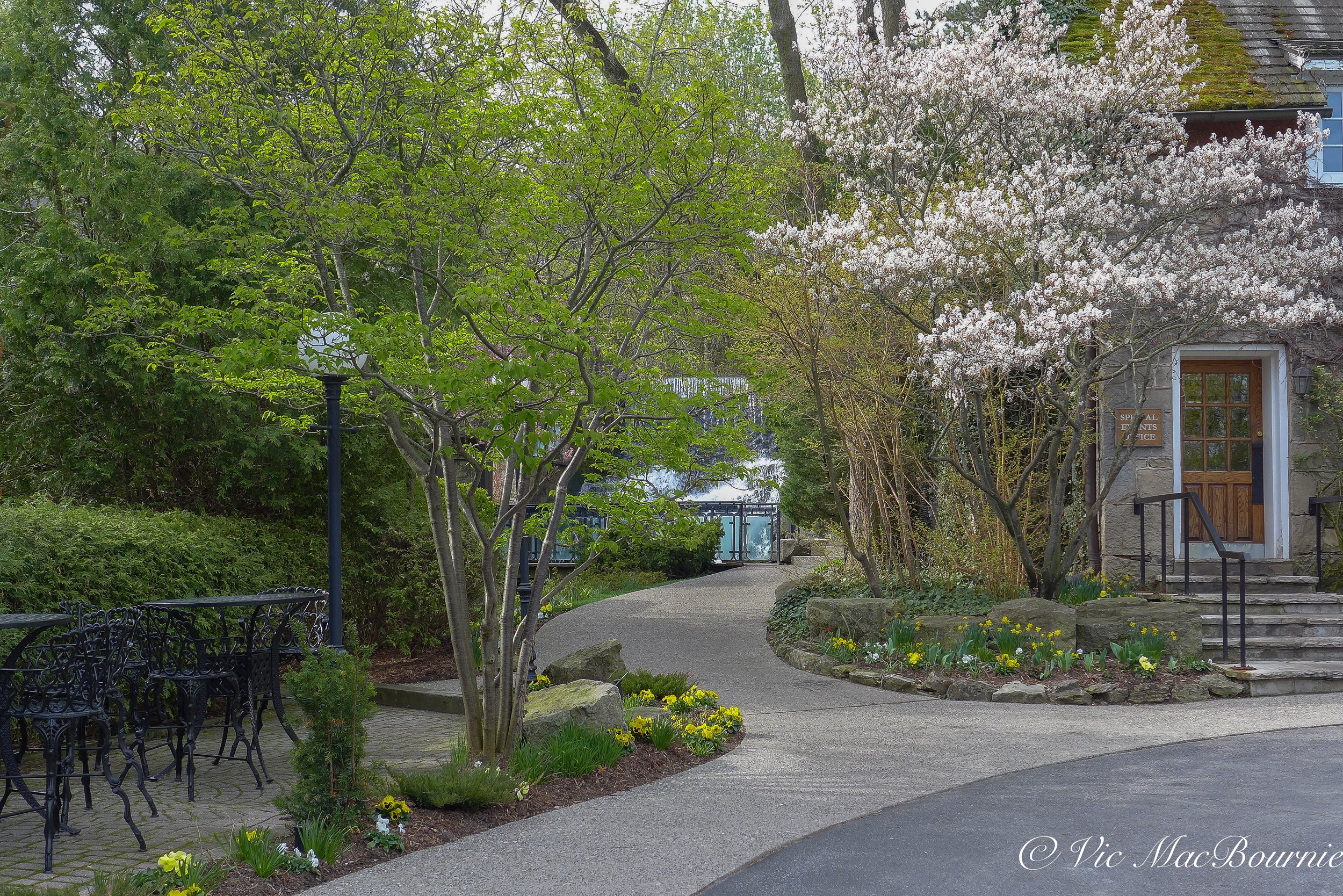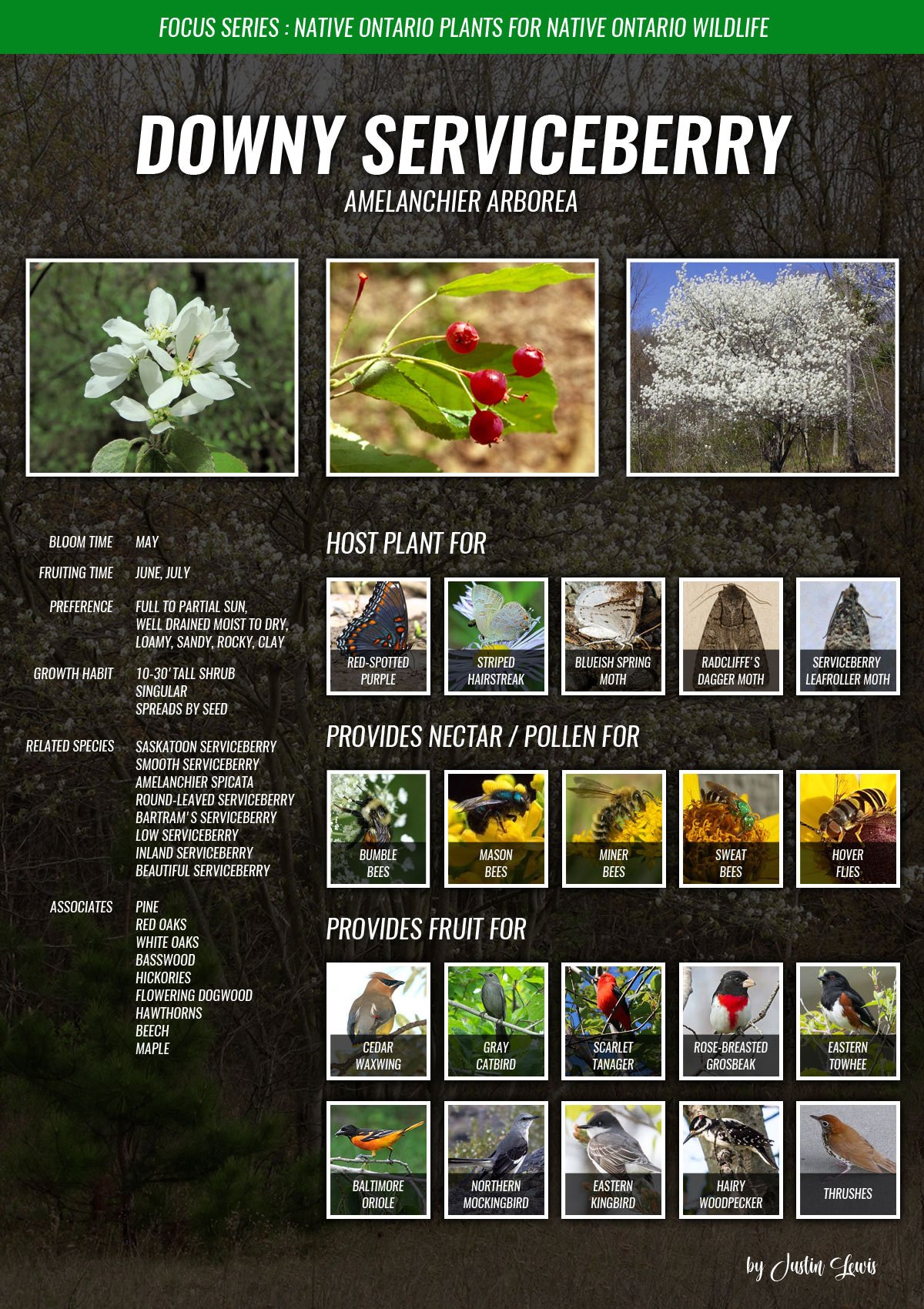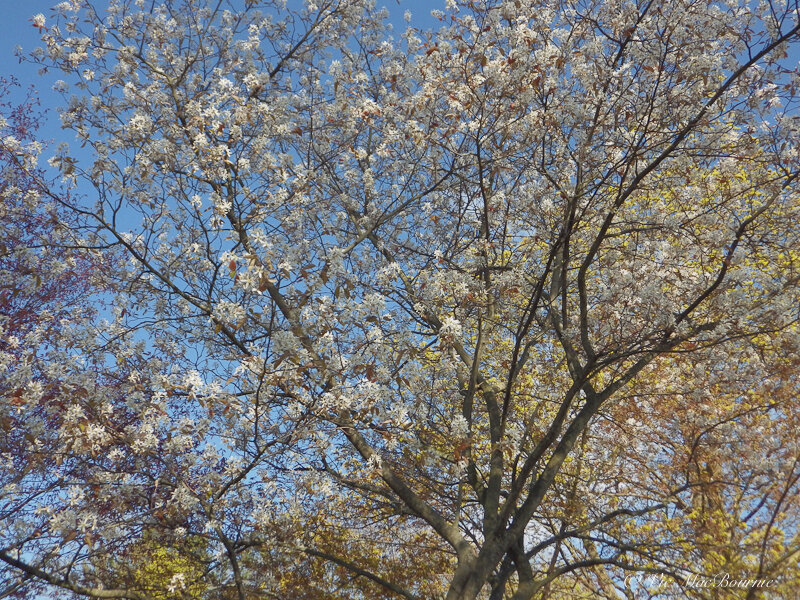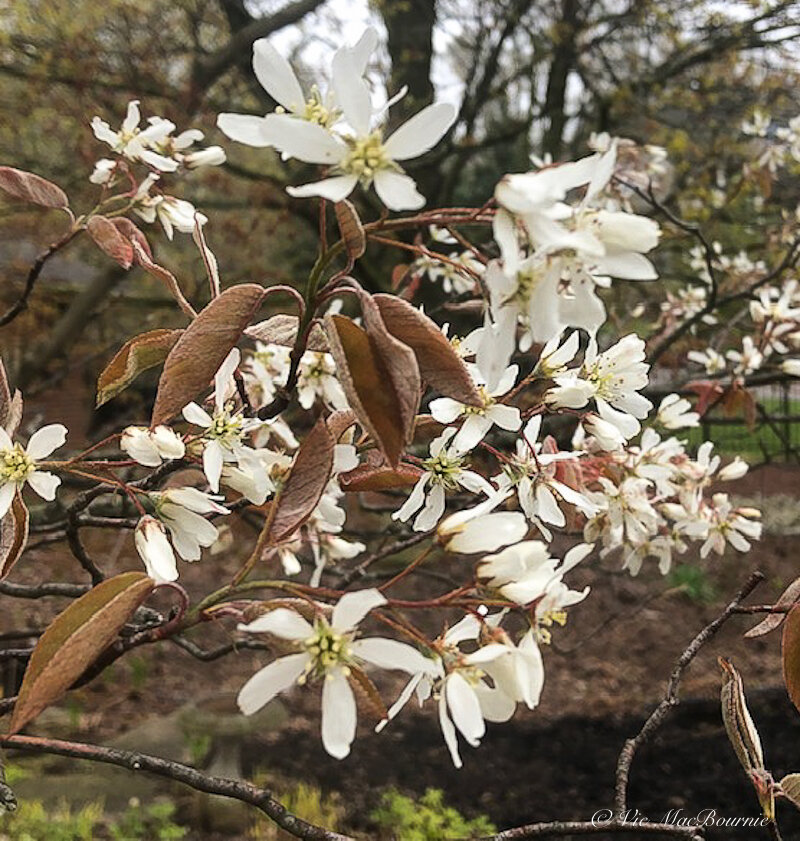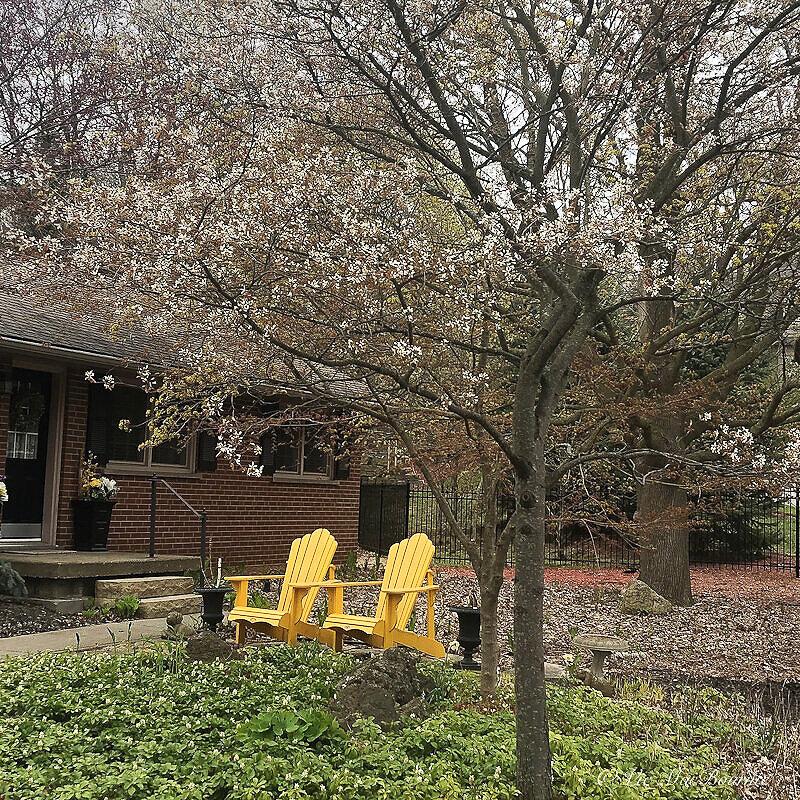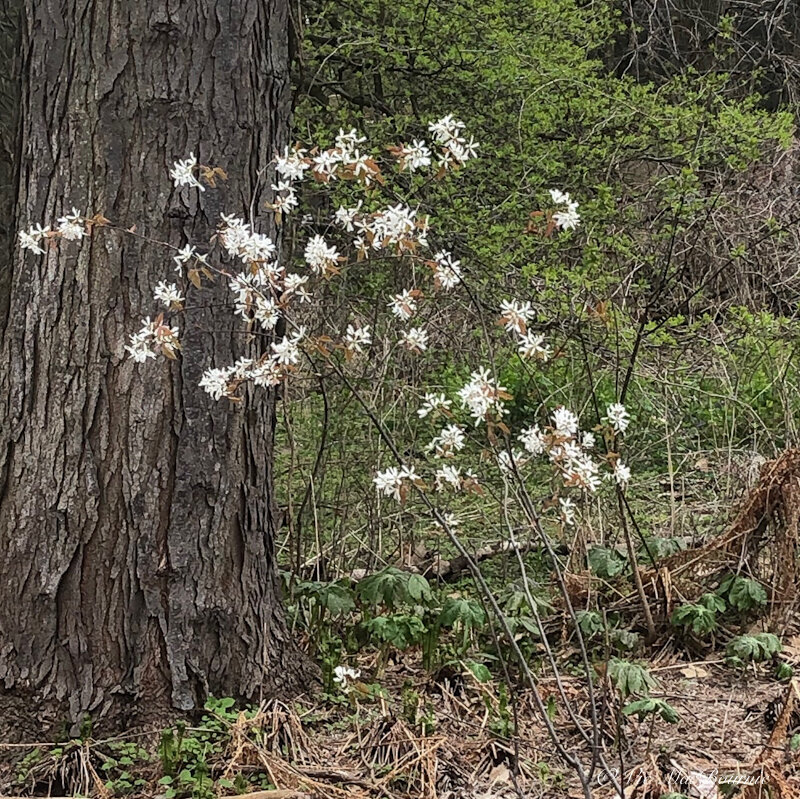Serviceberry: Ideal choice for attracting birds
More native plant gardeners are discovering the incredible value of the Serviceberry tree or shrub. A flush of delicate white flowers that cover the native trees and shrubs in early spring, followed by a profusion of deep red/purple berries creates a magnet for birds, bees and other wildlife. It’s the perfect understory tree for any woodland wildlife garden.
A beautiful multi-stem serviceberry in full bloom in early May. The lovely white flowers will be replace by juicy dark fruits that wildlife, especially berry-eating birds and chipmunks.
A magnet for Robins, Orioles and Cardinals
Looking for the perfect small native tree for your yard? Look no further than the Serviceberry tree.
In my garden these understory trees are a staple, together with dogwoods. My first was a single stem small tree that I planted in the front of the house close to 20 years ago. Since then I have planted several in the backyard, including multi-stem versions and a hybrid columnar form.
Amelanchier species can be grown as an understory tree or in shrub form and is hardy from zones 4 -9. Its delicate white sprays of flowers cover the trees in early spring (usually the first week of May where I live) and soon give way to massive amounts of juicy deep red/purple pome berries in June that are magnets to a host of birds, squirrels and chipmunks.
For my article on why native plants, shrubs and trees are important, go here.
Also known as juneberries, shad-blow, shadbush and Saskatoon berries, Amelanchier Canadensis is a member of the rose family. Both A. Canadensis and A. arborea are native to eastern North America ranging from Newfoundland west to southern Ontario and in the United States from Maine to the Carolinas.
Most of the trees and shrubs stay compact from about 6 feet in shrub form to about 25 feet tall in tree form, and are among the first to bloom in the spring woodlands providing important nectar and food sources for early emerging insects and pollinators including many native bees.
In the United States, the common serviceberry tree which is native to to the midwestern and eastern U.S. can grow to an impressive 40 feet tall in moist soil. It is a a wildlife favourite with more than 40 species of birds consuming the fruit including the cedar waxwing, eastern towhee and Baltimore oriole.
5 reasons to plant a serviceberry
• They are tough, adaptable small trees or shrubs that do well in most conditions
• Their spring flowers are among the earliest making them important native plants for early pollinators, including native bees
• Their fruit attracts a range of birds including robins, cardinals and orioles.
• They are native to Canada and the United States and an important addition to any woodland wildlife garden
• They are a host plant to butterflies and a food source for mammals
Poster created by Justin Lewis. Best viewed on tablet or desktop.
The spring bloom of the amelanchier is followed by the multitude of berries (similar to blueberries in size and flavour but sweeter) just in time to feed young birds that have fledged the nest and are looking for a good meal. Robins are often among the first to find the berries followed by orioles, thrushes, woodpeckers and cedar waxwings just to name a few.
Don’t be surprised if robins and cardinals decide to nest in the thick branches of the serviceberry.
Serviceberries trees are also important plants of the larvae of some of our favourite butterflies including tiger butterflies, viceroys and admirals.
Serviceberry flowers in full bloom from our 20-year-old tree in our front yard lights up the landscape for a few weeks in early May. The abundance of flowers will soon become berries to feed birds and other fauna.
If you garden in more remote areas, you can expect moose, deer, and other animals to browse on the leaves and twigs of the plant. The berries are also a favourite of chipmunks, squirrels and even the wily fox.
In Canada alone there are 24 species of Amelanchier that includes some varieties and some hybrids that are common in the wild. In fact Canada is a hot spot for Amelanchier diversity, potentially sporting the greatest variety in the world. Canada’s east coast boasts several including some that are quite rare (A. gaspensis and A nantuckitensis) and do not grow wild in Ontario.
The flowers of our Serviceberry in early spring. Notice that the flowers have emerged before the leaves are fully out.
The U.S. also has a few more species that are not in Ontario. All of the species share similar attributes including white flowers, gray bark and red/purple berries.
Most of these species are not grown in nurseries. In fact, most of the serviceberries seen at garden centres focus on four species – A. canadensis, A. alnifolia, A laevis and A. grandiflora.
Autumn Brilliance, a very popular nursery-grown hybrid serviceberry, is from the grandiflora species.
The many forms of wild serviceberry (Amelanchier) help illustrate their importance to native wildlife. Each flower has five long bright white petals. The flowers that bloom anywhere from March to June, depending on the species, usually grow in clusters at the end of new growth.
In Canada alone there are several forms from Amelanchier alnifolia that is native to parts of Ontario, British Columbia, Yukon and North West Territories. It grows up to three metres and can form large thickets. The flowers often precede the leaves and the fruit of this Saskatoonberry or western serviceberry is said to be the sweetest and juiciest of all the Canadian Amelanchiers.
A serviceberry in full bloom is the perfect understory tree in a woodland wildlife garden.
Amelancheir Arborea, (Link to Lady Bird Johnson Wildflower centre) also known as the Downy serviceberry or juneberry or common serviceberry is native to southern Ontario and southern Quebec where it is easily identified in spring bloom growing along forest edges and clearings often in dry soil, rocky or sandy areas. Downies grow most often as a small tree with leaves that are tapered to a point and are hairy when they are opening – which is where they pick up the name Downy.
A shrub form of the serviceberry shows off its incredible blooms that will later become a profusion of delicious berries that birds flock will likely get before you do.
Amelanchier laevis (Link to Lady Bird Johnson Wildflower centre) or often called smooth serviceberry or allegheny serviceberry are native to Western Ontario through to Newfoundland and are found in moist woodlands, clearing and roadsides.
Amelanchier stolonifera (Link to Lady Bird Johnson Wildflower centre) is a suckering shrub that grows to only about two metres tall and spreads to form thickets. It is found in the wild along sandy and rocky areas in dry woodlands, along cliffs and dunes.
Serviceberries are not picky about soil conditions and do well in sun or part-shade conditions. In the wild it is most often found growing in wet areas but, some species can be found growing in harsh areas along granite and limestone cliffs.
If all of these highlights still has not go you convinced that a serviceberry is a must for your woodland garden, consider that its fall colours are spectacular with blazing foliage in reds oranges and yellows.
Serviceberries in our garden
In our garden we are blessed with both the tree form and a small shrub that I was lucky enough to score at our annual local horticultural society sale. I planted that a few years ago, and just this year it is really putting on a nice show in the woodland garden.
Our tree form is more than 20 years old and has matured into a beautiful specimen that puts on a magnificent show every year during the first week of May. It throws the perfect light shade on the wildflower garden below and coexists nicely with a Japanese maple. Both trees have begun to merge branches forming a lovely open canopy over the native plants below, including solomon’s seal, columbine, bloodroot, wild geranium and foamflower, and non-natives that include epimedium.
Propagating from cuttings and seed
Serviceberries are easily propagated and can be rooted from early spring hardwood cutting or softwood cuttings taken during the summer months. If you want to plant them from seeds, you are going to have to collect some berries when they begin ripening and turning red to purple. Give the seeds a quick cleaning and plant them in the fall. If you plan to grow them in trays, you will have to stratify the seeds and store them in the fridge for at least three months.
More links to my articles on native plants
Why picking native wildflowers is wrong
The Mayapple: Native plant worth exploring
Three spring native wildflowers for the garden
A western source for native plants
Native plants source in Ontario
The Eastern columbine native plant for spring
Three native understory trees for Carolinian zone gardeners
Ecological gardening and native plants
Eastern White Pine is for the birds
Native viburnums are ideal to attract birds
The Carolinian Zone in Canada and the United States
Dogwoods for the woodland wildlife garden
Bringing Nature Home by Douglas Tellamy
A little Love for the Black-Eyed Susan
Native moss in our gardens
As an affiliate marketer with Amazon or other marketing companies, I earn money from qualifying purchases.



